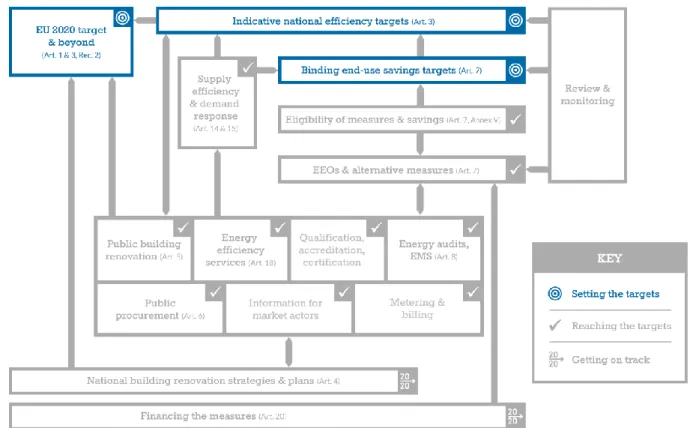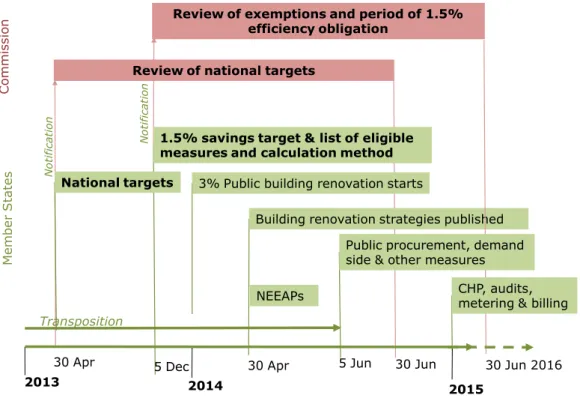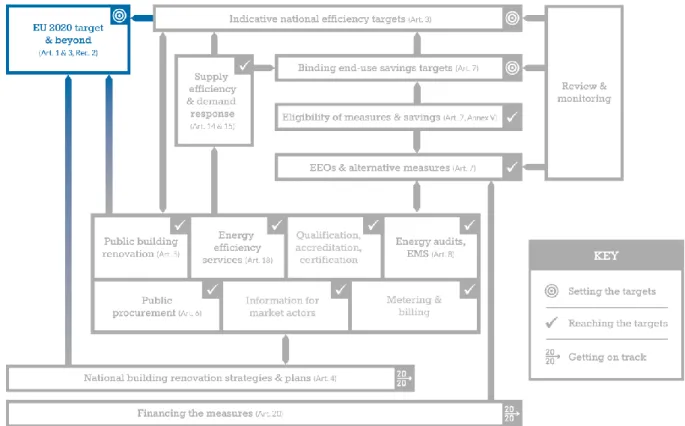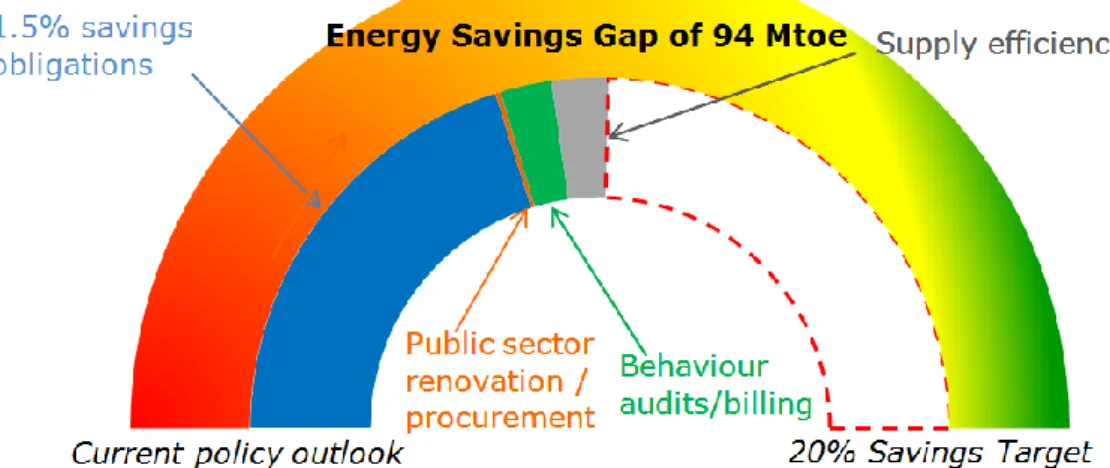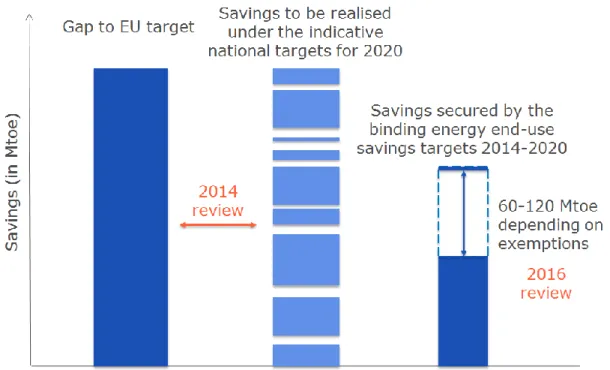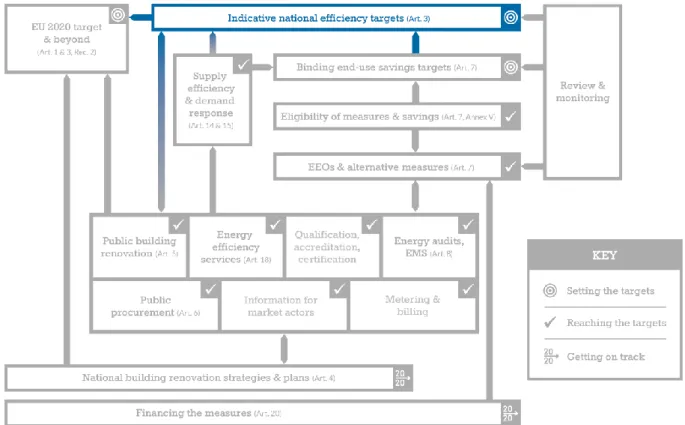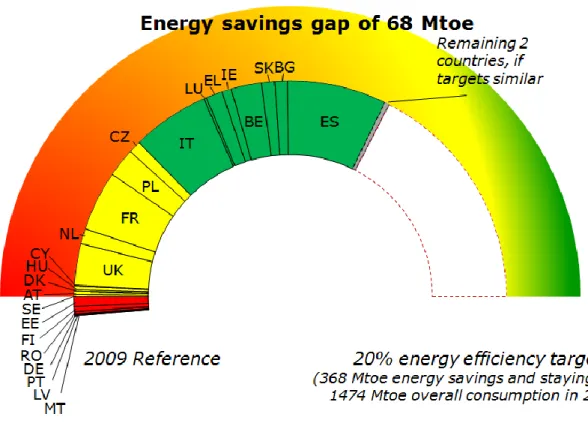We are encouraged by the Coalition's Guidebook for the strong implementation of the Energy Efficiency Directive. The Energy Efficiency Directive (EED) came into force on 4 December 2012 and repeals the Cogeneration Directive (2004/8/EC) and the Energy End-Use Efficiency and Energy Services Directive (2006/32/EC).
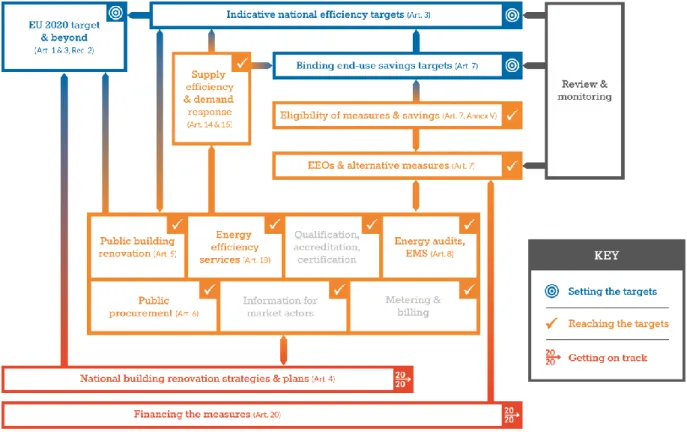
S UMMARY OF C OALITION RECOMMENDATIONS
B ACKGROUND
"Energy efficiency" means the ratio of output of performance, service, goods or energy to energy input (Article 2.4). Energy saving means an amount of energy saved by measuring and/or estimating consumption before and after the implementation of a measure to improve energy efficiency, while ensuring normalization for external conditions affecting energy consumption (Article 2.5) .
T HE EU ENERGY SAVINGS TARGET FOR 2020 AND BEYOND (A RTICLES 1 AND 3 AND R ECITAL 2)
The Coalition's Gapometer shows that the EED's minimum requirements for measures adopted in the EED will not be sufficient to meet the EU's energy savings target and will in fact leave a gap of around 94 Mtoe7. 6 PRIMES is the energy system model used by the European Commission for the EU's energy projections.
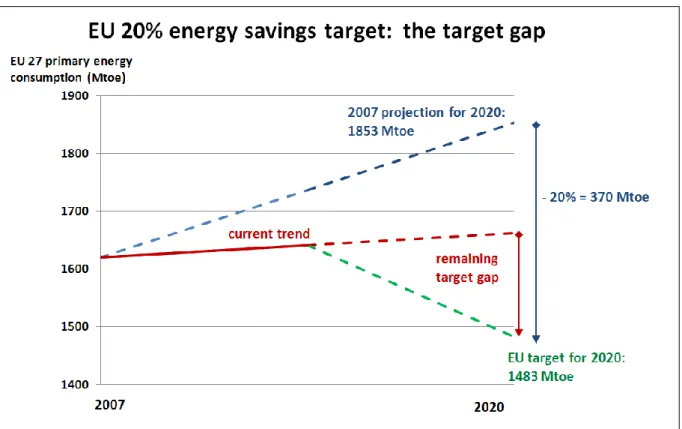
I NDICATIVE NATIONAL ENERGY EFFICIENCY TARGETS (A RTICLE 3)
Green indicates targets that would achieve significant energy savings beyond the minimum requirements of the EED. An explanation of how the target and progress contribute to achieving the EU 2020 energy savings target of 20% (see Article 3.1(a) and Annex XIV, Part 1).
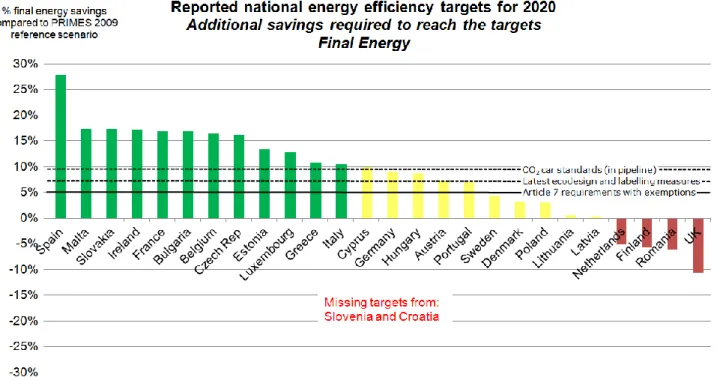
B INDING ENERGY END - USE SAVINGS TARGETS (A RTICLE 7)
The exemptions below (phase-in, energy exclusion, ETS sold to industry, supply-side savings and early action) can be combined but cannot lead to a total reduction of more than 25% of the target as defined in Article 7.1. Challenge the potential use of banking and borrowing options for energy efficiency obligation schemes (see Article 7.7(c)), which would reduce the final energy savings target, but which the coalition believes would be against the law.
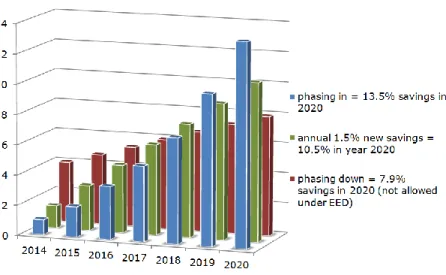
E LIGIBILITY OF MEASURES FOR THE ENERGY END - USE SAVINGS TARGET (A RTICLE 7, A NNEX V)
The size of any energy savings resulting from pricing policies designed to increase energy efficiency is governed by the product of the percentage increase by price measures, such as energy or CO2 taxes, from previous levels and the price elasticity. Long-run elasticities allow for the effect of consumer prices on the development of the capital stock as it changes and improves over time (as equipment suppliers respond to the changing balance in capital and fuel costs). Significant changes in capital stock due to policy-induced price changes are unlikely to occur within the time frame of the EED.
If disposable income also increases during this period, the impact of the price increase becomes even smaller than the price elasticities would indicate. 19 To ensure comparability and distinguish between the effects of fuel switching and energy saving, refer to Annex IV of the EED for the relevant conversion factors.
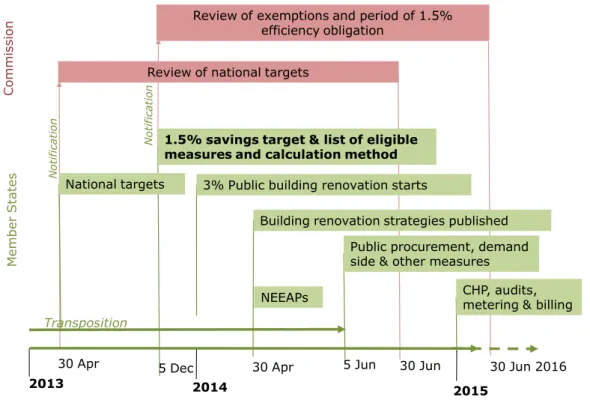
E NERGY EFFICIENCY OBLIGATION SCHEMES & ALTERNATIVES (A RTICLE 7)
However, in the EU, most of the delivered energy savings have come through the use of estimated or ex ante savings for specific energy efficiency measures. It is clear that the European Commission must have confidence in the energy savings resulting from EEOs (or indeed any energy efficiency policy involving the supposed energy saving. The common principle is that part of the energy supply chain is clearly committed to delivering energy savings .
Finally, to avoid “stop-go” market activity for the energy efficiency industry, it has been good practice to allow the storage of energy savings from one phase of the EEO to the next29. EEO managers must ensure that the value of longer life energy efficiency measures is fully reflected in how the EEO target for energy savings is set.
P UBLIC BUILDING RENOVATIONS (A RTICLE 5)
Irrespective of the approach taken, the implementation of Article 5 should start on 1 January 2014 in government buildings with a total usable floor area of more than 500 m2. The EED provides a useful complement to the Energy Performance of Buildings Directive (Directive 2010/31/EU) in the field of renovation of existing public buildings. Renovation of central government buildings to at least meet the national minimum energy performance requirements set in the EPBD;
As such, they should be linked to the "inventory" of the building stock required under Article 4. Therefore, all Member States should create an inventory of their government buildings, regardless of the approach chosen to meet the requirements of Article 5.
E NERGY EFFICIENCY IN PUBLIC PROCUREMENT (A RTICLE 6)
The energy efficiency requirements used by the public sector set an example for the private sector. Guidelines, preferably in law, on the stages of the public procurement process in which energy efficiency must be assessed; All levels of administration (at national, regional and local level) to apply the energy efficiency requirements of public procurement; and.
The United States to apply higher standards than required under the EED public procurement provisions, including the requirement for "high energy efficiency performance" for products not covered by Annex III. To be effective, energy efficiency standards must be implemented at the appropriate stage of the public procurement procedure.
E NERGY A UDITS (A RTICLE 8)
The EED gives energy audits and energy management schemes a significant role to play in improving energy efficiency in the end-use sectors. It is important to bear in mind the intended use of energy audits in the EED. The EED also encourages MSs to set up support schemes for SMEs and to conclude voluntary agreements to cover or cover the costs of the actual energy audits and implementation of the recommendations.
In addition to the key elements of energy audit and energy management in the summary for this chapter, it is important to be aware of a number of details stated or implied in Article 8, Annex VI and other parts of the EED. Energy audits that meet the minimum financial and economic criteria and requirements laid down in Article 8 and Annex VI of the EED, as well as investment quality audits, are promoted.
E NERGY EFFICIENCY SERVICES (A RTICLE 18)
Support the European Commission in actions to change the interpretations of EUROSTAT rules on public debt and deficits, which consider investments in energy efficiency under energy service contracts as public deficits in the National Accounts, even if they are organized under ESCOs. Ensure that MSs evaluate and remove regulatory and non-regulatory barriers to energy efficiency (Article 19.1). The results of this must be described in the first National Energy Efficiency Action Plan due on 30 April 2014.
Support the European Commission in its actions to change the interpretations of the EUROSTAT rules on public debt and deficit, which treat energy efficiency investments under energy service contracts as deficits in the national accounts, even if they are organized under ESCO. Encourage Member States to follow their own VAT rules when they are not in favor of energy efficiency services.
S UPPLY SIDE EFFICIENCY AND DEMAND RESPONSE (A RTICLES 14 AND 15)
In addition, Member States must make the comprehensive assessment of the potential for high-efficiency cogeneration and district heating and cooling available to the European Commission by 31 December 2015 at the latest. The definitions, reference values and methodology of the CHP Directive have been transferred (as a harmonized set of criteria at EU level) to the EED. Confirm that the comprehensive assessment of the potential for high-efficiency cogeneration and district heating and cooling includes all information listed in Annex VIII by 31 December 2015.
Reaffirmation of the rule for priority access to cogeneration (in full compliance with renewable energy sources); Promoting the construction and expansion of heating and cooling networks that work with heat from CHP installations.
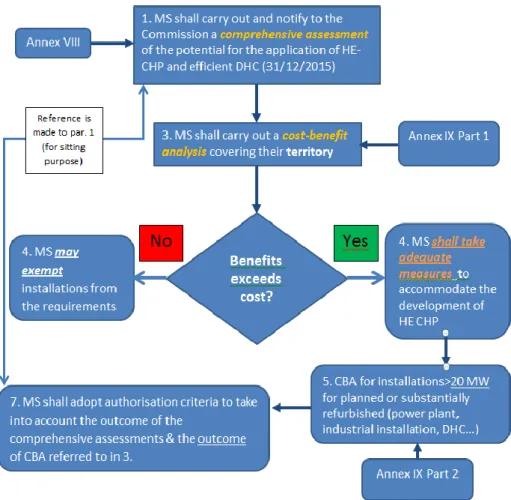
N ATIONAL BUILDING RENOVATION STRATEGIES AND PLANS (A RTICLE 4)
Advocates an 80% reduction in energy consumption for the building stock, to be achieved by improving the energy performance of buildings by 2050. The inventory of public buildings should be expanded to include an inventory of the entire building stock. The inventory is also a precondition for implementing the available and future policies and measures, tailored to the specific national circumstances of the building stock.
The expected savings for the different policies and measures should be assessed and compared to the long-term savings potential of the entire national building stock. Encourage Member States to develop a policy landscape that encourages cost-effective deep renovations of the building stock.
F INANCING THE MEASURES (A RTICLE 20)
The European Energy Efficiency Fund, established by the European Investment Bank (EIB) and other national banks;. A substantial source of affordable and long-term upfront funding to support energy efficiency investment is critical to ensuring that the government's energy efficiency ambitions are realised. In the European Union, there are many funds that are partially or fully dedicated to financing energy efficiency in the member states.
Britain's Green Deal: An innovative trial to tackle split incentives and boost take-up of energy efficiency loans for buildings. The Green Deal scheme, which started in 2013, links the energy efficiency loan to the building rather than the owner (addressing split incentives).

T IMELINE OF THE E NERGY E FFICIENCY D IRECTIVE OBLIGATIONS
Information For end customers without smart meters, Member States shall ensure that billing information is accurate and based on actual consumption. Member States shall provide certification and accreditation schemes or equivalent schemes if the existing ones are considered insufficient. Comprehensive assessment by Member States of the potential of high-efficiency cogeneration and efficient district heating and cooling.
12/31/2016 Article 9 - Metering In multi-apartment and multi-purpose buildings with central heating or hot water heating systems, individual meters are installed 6/30/2018 Article 24 - Overview. The Commission's assessment of progress in removing regulatory and non-regulatory barriers referred to in Article 19(1).
E LIGIBILITY OF MEASURES AND SAVINGS TO COUNT TOWARDS THE ENERGY END - USE SAVINGS TARGET
This section covers the topics necessary to ensure that the energy savings claimed against the EED targets are additional and that the activities of the obliged or authorized parties have had a significant impact on the final consumer's decision to invest in an energy efficiency measure. It is important to ensure that any subsidy or participation by the obliged or authorized party has a clear material effect on the end-user's decision to make an energy efficiency investment. Member States must ensure that energy efficiency measures are installed in accordance with the relevant quality standards.
This involves ensuring that the energy efficiency measure meets the energy performance requirements and that (where applicable) it has been installed in accordance with applicable best practice guidelines. Some obligations require that a certain fraction of the energy savings target be met by energy efficiency measures in low-income households.
B UILDING RENOVATION CONCEPTS
G OOD PRACTICES IN PRACTICE : BOOSTING THE ENERGY SERVICES MARKET
C ASE STUDIES : INNOVATIVE USE OF S TRUCTURAL F UNDS FOR EE FINANCING
O VERVIEW OF MAIN EU ENERGY EFFICIENCY LEGISLATION
